Some people visit a city to do something very specific. For example: to run a marathon.
There is actually no such thing as a marathon season – as the running events are always planned according to the respective climate, they are more or less spread out over the whole year. If you add in explicit winter events, you can actually always run somewhere.
We have put together a few running events in Europe. There are events in Italy, Spain, Greece, Germany … Maybe there’s something for you.
Europe is home to several World Marathon Majors, including the iconic London Marathon and the record-breaking Berlin Marathon. These prestigious events attract top athletes from around the globe, offering a unique and challenging experience for runners. The World Marathon Majors series is a collection of the most renowned marathons in the world, and participating in one is a dream for many runners. These marathons are not just races; they are celebrations of endurance, determination, and the human spirit.
Two things make these running events so attractive for active people: Firstly, in many cities you run on very special routes, usually right through the (historic) centres of the city. How exciting! What a unique perspective! And secondly, if you’re already there, it’s really worth taking the time to see one or two sights at your leisure.
Also very special, for instance, is the Istanbul Marathon. This is the only marathon in the world that spans two continents, offering a unique experience as runners cross the Bosphorus Bridge from Europe to Asia.
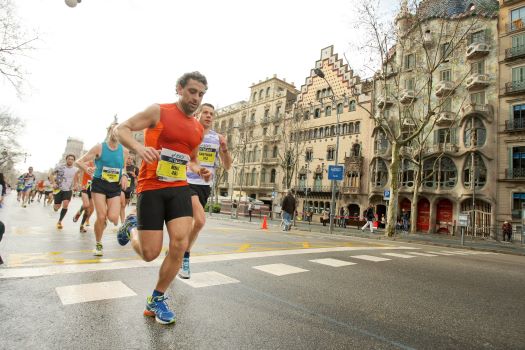
The Barcelona Marathon – also known as the Marathon Catalunya – starts and finishes at the foot of the green Montjuic hill. The race runs through the city centre and the course takes runners past the FC Barcelona stadium, Gaudí’s masterpieces La Pedrera and the Sagrada Familia as well as other UNESCO World Heritage Sites. This makes the marathon in Barcelona a unique experience for runners from all over the world, who can experience the Mediterranean culture as well as the truly unique architecture in the cosmopolitan atmosphere. With up to 25,000 starting places – from young to old, from local to international, from wheelchair athlete to champion – there is room for every participant.
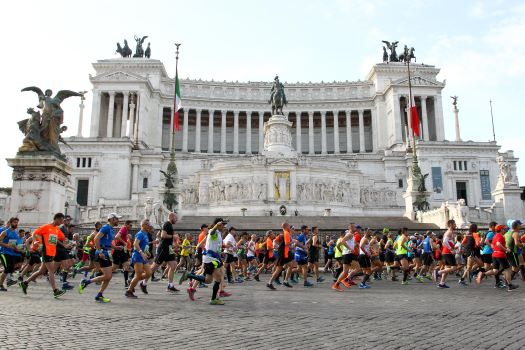
Few cities offer such a spectacular backdrop for a marathon as Rome. The start and finish in the shadow of the Colosseum are simply unique. Although Rome was built on seven hills, the course of the race is fairly flat. It leads past famous sights such as the Trevi Fountain, the Pantheon and St Peter’s Basilica. On the one hand, the flat course is good for personal bests, but on the other hand, be careful – the cobblestones on the course are tough. Thousands of national and international runners have been meeting in front of this unique backdrop since 1995. Held in spring, the Rome Marathon is also a very pleasant time to experience the city.
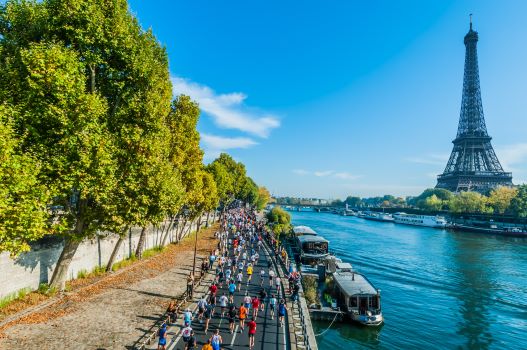
The Paris Marathon is one of the most popular running events in Europe. No wonder that there is also a trade fair for everything to do with running at the same time as the big event. The race runs through a beautiful city, past iconic and unmistakable sights. The start is on the Champs-Elysees, the route leads over the Place de la Concorde past the Louvre, around the Place de la Bastille past the Ile de la Cite and Ponte Neuf … This list alone is enough to make any city traveller’s heart beat faster. With up to 52,000 participants, the Paris Marathon is also really well attended. But, as I said, it really is a “once in a lifetime” event.
The Hamburg Marathon is one of the most popular running events in Germany. However, with around 13,500 participants, it is much more manageable than the Berlin Marathon, for example. On their way through the city, the starters run through famous and notorious neighbourhoods such as the Reeperbahn, the streets along the Elbe and around the Alster. The run becomes a sightseeing tour! The organisation and the enthusiastic spectators who cheer the participants on to the finish line are often praised in particular. The alternation of urban and green sections on the route offers something for every runner – whether you are an ambitious athlete or a leisure runner, everyone will find what they are looking for here.
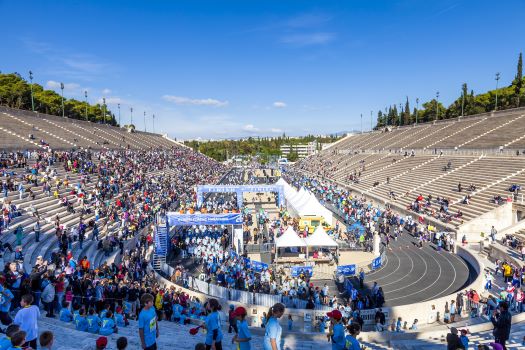
Well, Athens is like the mother of all marathons – at least in the Greek capital you are very close to the historical reference point. If the Greek soldier Phidippides is commemorated anywhere, it is here. The Athens Marathon virtually follows the original route from the ancient city of Marathon to the Olympic Stadium in Athens.
However, this route is also considered challenging. After a relatively flat starting section of around 12 kilometres, the next 19 kilometres follow with long, undulating hills. Fortunately, the final section with its slightly sloping terrain provides a tailwind again. Those who have managed this will cross the finish line in the beautiful Panathinaikon Stadium in Athens.
The Berlin Marathon, originally founded by a running group, is now one of the biggest running events in the world. World-class runners compete here and new records are regularly reported, maybe you could call Berlin the fastest marathon. (New world records have been set here 12 times so far!)
Back in 1990, just a few days before the official reunification of Germany, the course was run through the Brandenburg Gate for the first time, uniting both sides of the divided city of Berlin with a first visible sign of solidarity. For an event of this importance and size, everything is of course perfectly organised, but this is just one of the many things that make the Berlin Marathon so popular with runners: Not only can you run with the greats of your sport here, but the route also takes you along a historically significant route that is rich in sights. Not to forget: The spectators and their support impress many participants and spur them on to top performances.
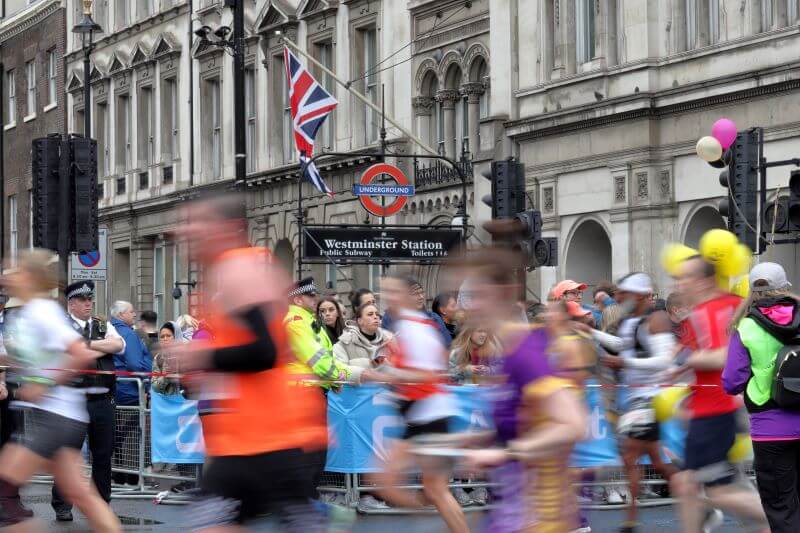
The London Marathon, one of the six World Marathon Majors, is a must-run event for marathon enthusiasts. The London Marathon takes runners on a scenic journey through the heart of the city, past some of its most famous landmarks. The course is a point-to-point route that starts in the east end of the city and winds its way to the heart of London. Here, Runners pass by some of the most iconic landmarks, including the majestic Tower Bridge and the historic Buckingham Palace.
The finish line, located near Buckingham Palace, provides a grand and memorable conclusion to the race. The London Marathon is renowned for its festive atmosphere, with thousands of spectators lining the streets to cheer on the runners. It’s an event that combines the thrill of the race with the beauty and history of one of the world’s greatest cities.
Many city travellers heading to Europe are of course familiar with the big, famous cities, and most of them rightly have a reputation as a great destination for a short trip, for example. But smaller cities that are not at the top of the bucket list can also be attractive destinations and offer unique running experiences. Be it that the city itself is simply worth seeing, or that it is simply located in an enchanting setting. In the best case: both.
But you can also run in less urban settings – with fewer sights but more flair. Running in the most idyllic areas of Europe sounds like a really good idea. Take for example the Jungfrau Marathon in Switzerland which is renowned for its challenging uphill course, set against the breathtaking backdrop of the Jungfrau Mountain and Lauterbrunnen Valley.
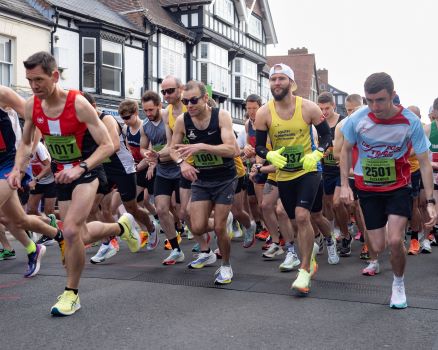
In Stratford-upon-Avon (Warwickshire, UK), the race follows an idyllic, rural route with one lap of the half marathon distance and two laps of the full marathon distance. Most of the route is on closed roads around the town, with the remainder on the Stratford Greenway footpath, a tough, compact walkway ideal for a good race with healthy ambition! The route runs from the town centre past the racecourse to Luddington and Welford-on-Avon, before returning to Stratford-upon-Avon on the Stratford Greenway. In other words: a race through a fantastic English landscape that, for all its sportiness, holds the promise of cosiness. After all, every participant has truly earned their next pub visit.
In summer, the Marburg Night Marathon offers runners the opportunity to run into the night in a small medieval town and along the banks of the River Lahn. A half marathon is also possible here. The small university town is located in the centre of Germany on the banks of the River Lahn and in the hilly uplands of a low mountain range. With its rich history, it also offers tourists and other visitors plenty of variety. The start is on Marburg’s historic market square and the route is flat, so you can catch a glimpse of the beautiful surroundings on the roads and paths – until night falls on the night marathon.
Some venues are a little more difficult to reach than others. The city of Tromsø is probably one of them. However, the small town in the north of Norway offers very special conditions for the running events there. Both the Midnight Sun Marathon and the Polar Night (Half) Marathon take advantage of the city’s location above the Arctic Circle: While the sun is still shining at midnight for the Midnight Sun Marathon, participants in the Polar Nights (Half) Marathon run their race in complete darkness – in the middle of the day. The route is illuminated with colourful torches. And, don’t forget: in the darkness of the polar night, you always have the chance to see the Northern Lights. An unforgettable experience for sure! But remember, running here is challenging, as it’s not only dark but also really cold.
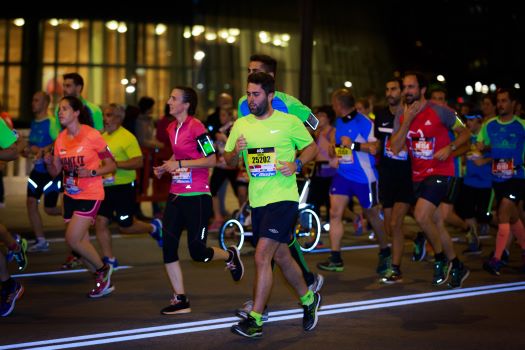
The Bilbao Night Marathon offers around 10,000 participants the chance to run through the breathtaking streets of the capital of the Bizkaya region. With its three distances, marathon, half marathon and 10-kilometre pirate run, it is the ultimate night run in the Spanish calendar. The night marathon not only offers a beautiful course, but also an incredible running party with 8 entertainment points along the route and thousands of spectators cheering on the runners. Here the participant is the star of the evening.
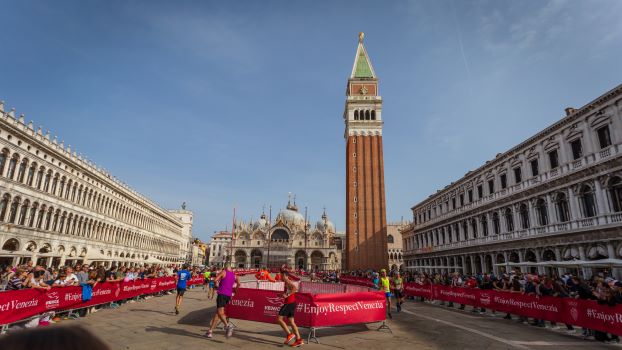
A maximum of 8000 runners are allowed to compete here – there simply isn’t that much space in the famous Italian lagoon city. The course is flat and famous for the 14 bridges that the runners cross. If necessary, the organisers sometimes add a bridge to the cityscape. With events in the run-up to the marathon, the city attracts running enthusiasts from young to old. The start is in the garden of Villa Pisani, which opens its doors free of charge to celebrate the marathon. Unsurprisingly, a large part of the route is actually on the water – a unique setting for runners and spectators.
The marathon in Florence takes you through centuries of art, history and culture and offers a unique experience for international runners. The event attracts thousands of dedicated athletes from all over the world on the last Sunday in November. The route passes iconic landmarks, including the breathtaking Tuscan hills and the bustling Piazza del Duomo, Piazza della Signoria and Ponte Vecchio. Increasingly popular with national and international runners, Florence is the second largest marathon in Italy. The challenging course leads through narrow streets, but also offers breathtaking views of the Italian countryside and architectural masterpieces.
For those who are not quite ready to tackle a full marathon, half marathons offer a fantastic alternative, a challenging but less demanding experience. Europe boasts a wide range of half marathons, from flat and fast courses to hilly and challenging routes. Many of these events take place in beautiful cities, providing a unique and scenic course that showcases the best of the local surroundings. Often, when a city has a marathon event, you can also opt for the half marathon version. Popular events include the Paris Half Marathon, the Berlin Half Marathon, and the London Half Marathon. The finish line is often located in a central location, creating a festive and celebratory atmosphere for both runners and spectators. These events are perfect for those looking to test your endurance while enjoying the sights and sounds of Europe’s most captivating cities. Whether you’re a seasoned runner or a newcomer to the sport, half marathons offer a rewarding and memorable experience.
Our small selection is sure to have something for every running enthusiast. Of course, we can only include a small selection of the countless marathons and running events that take place in Europe alone. There are so many beautiful cities and other places that are worth a visit. Not just to run, of course, but perhaps for a quieter visit, with plenty of sightseeing, experiencing the local way of life and immersing yourself in the culture and history of the place you’re in. Some people travel just to walk. Others tend to move at a more leisurely pace. And both have wonderful encounters and experiences in the wonderfully different places we visit. European marathons offer a unique way to explore the rich history and diverse landscapes of the continent, making them a perfect addition to any travel itinerary.